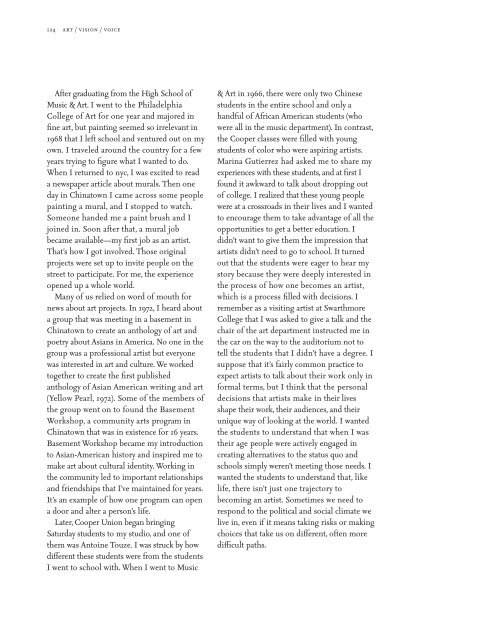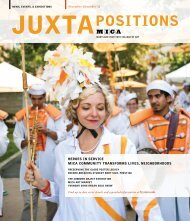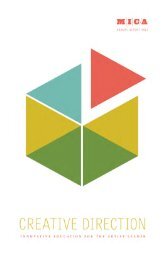art/vision/voice - Maryland Institute College of Art
art/vision/voice - Maryland Institute College of Art
art/vision/voice - Maryland Institute College of Art
Create successful ePaper yourself
Turn your PDF publications into a flip-book with our unique Google optimized e-Paper software.
124 <strong>art</strong> / <strong>vision</strong> / <strong>voice</strong><br />
After graduating from the High School <strong>of</strong><br />
Music & <strong>Art</strong>. I went to the Philadelphia<br />
<strong>College</strong> <strong>of</strong> <strong>Art</strong> for one year and majored in<br />
fine <strong>art</strong>, but painting seemed so irrelevant in<br />
1968 that I left school and ventured out on my<br />
own. I traveled around the country for a few<br />
years trying to figure what I wanted to do.<br />
When I returned to nyc, I was excited to read<br />
a newspaper <strong>art</strong>icle about murals. Then one<br />
day in Chinatown I came across some people<br />
painting a mural, and I stopped to watch.<br />
Someone handed me a paint brush and I<br />
joined in. Soon after that, a mural job<br />
became available—my first job as an <strong>art</strong>ist.<br />
That’s how I got involved. Those original<br />
projects were set up to invite people on the<br />
street to p<strong>art</strong>icipate. For me, the experience<br />
opened up a whole world.<br />
Many <strong>of</strong> us relied on word <strong>of</strong> mouth for<br />
news about <strong>art</strong> projects. In 1972, I heard about<br />
a group that was meeting in a basement in<br />
Chinatown to create an anthology <strong>of</strong> <strong>art</strong> and<br />
poetry about Asians in America. No one in the<br />
group was a pr<strong>of</strong>essional <strong>art</strong>ist but everyone<br />
was interested in <strong>art</strong> and culture. We worked<br />
together to create the first published<br />
anthology <strong>of</strong> Asian American writing and <strong>art</strong><br />
(Yellow Pearl, 1972). Some <strong>of</strong> the members <strong>of</strong><br />
the group went on to found the Basement<br />
Workshop, a community <strong>art</strong>s program in<br />
Chinatown that was in existence for 16 years.<br />
Basement Workshop became my introduction<br />
to Asian-American history and inspired me to<br />
make <strong>art</strong> about cultural identity. Working in<br />
the community led to important relationships<br />
and friendships that I’ve maintained for years.<br />
It’s an example <strong>of</strong> how one program can open<br />
a door and alter a person’s life.<br />
Later, Cooper Union began bringing<br />
Saturday students to my studio, and one <strong>of</strong><br />
them was Antoine Touze. I was struck by how<br />
different these students were from the students<br />
I went to school with. When I went to Music<br />
& <strong>Art</strong> in 1966, there were only two Chinese<br />
students in the entire school and only a<br />
handful <strong>of</strong> African American students (who<br />
were all in the music dep<strong>art</strong>ment). In contrast,<br />
the Cooper classes were filled with young<br />
students <strong>of</strong> color who were aspiring <strong>art</strong>ists.<br />
Marina Gutierrez had asked me to share my<br />
experiences with these students, and at first I<br />
found it awkward to talk about dropping out<br />
<strong>of</strong> college. I realized that these young people<br />
were at a crossroads in their lives and I wanted<br />
to encourage them to take advantage <strong>of</strong> all the<br />
opportunities to get a better education. I<br />
didn’t want to give them the impression that<br />
<strong>art</strong>ists didn’t need to go to school. It turned<br />
out that the students were eager to hear my<br />
story because they were deeply interested in<br />
the process <strong>of</strong> how one becomes an <strong>art</strong>ist,<br />
which is a process filled with decisions. I<br />
remember as a visiting <strong>art</strong>ist at Sw<strong>art</strong>hmore<br />
<strong>College</strong> that I was asked to give a talk and the<br />
chair <strong>of</strong> the <strong>art</strong> dep<strong>art</strong>ment instructed me in<br />
the car on the way to the auditorium not to<br />
tell the students that I didn’t have a degree. I<br />
suppose that it’s fairly common practice to<br />
expect <strong>art</strong>ists to talk about their work only in<br />
formal terms, but I think that the personal<br />
decisions that <strong>art</strong>ists make in their lives<br />
shape their work, their audiences, and their<br />
unique way <strong>of</strong> looking at the world. I wanted<br />
the students to understand that when I was<br />
their age people were actively engaged in<br />
creating alternatives to the status quo and<br />
schools simply weren’t meeting those needs. I<br />
wanted the students to understand that, like<br />
life, there isn’t just one trajectory to<br />
becoming an <strong>art</strong>ist. Sometimes we need to<br />
respond to the political and social climate we<br />
live in, even if it means taking risks or making<br />
choices that take us on different, <strong>of</strong>ten more<br />
difficult paths.
















